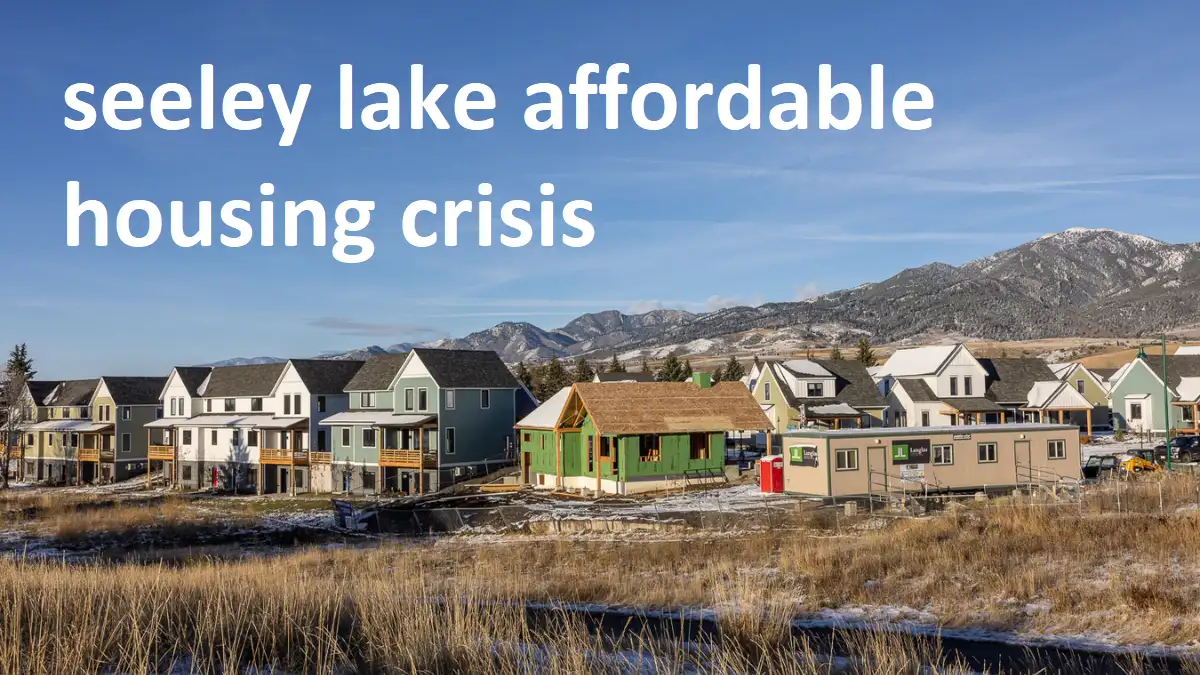Understanding the Seeley Lake Affordable Housing Crisis
The Seeley Lake Affordable Housing Challenge Nestled in the heart of Montana’s stunning landscapes, Seeley Lake is often viewed as a picturesque haven for nature lovers and outdoor enthusiasts. However, beneath its scenic charm lies a pressing issue that has garnered significant attention in recent years: the affordable housing crisis. This article delves into the complexities of the situation, exploring its causes, implications, and potential solutions.
The Current State of Affordable Housing in Seeley Lake
Overview of Housing Demand and Supply
As the population of Seeley Lake has steadily increased, driven by both permanent residents and seasonal visitors, the demand for housing has surged. The allure of the region, characterized by its beautiful lakes and proximity to recreational activities, has attracted many new residents seeking a tranquil lifestyle. Unfortunately, the supply of affordable housing has not kept pace with this demand.
According to recent census data, Seeley Lake’s population has grown by over 20% in the last decade, further straining the housing market. With the influx of people, many residents find themselves caught in a financial squeeze, with wages not aligning with the rising costs of housing. For low- and middle-income families, the dream of homeownership or even securing a stable rental unit feels increasingly out of reach.
The Impact of Rising Costs
The prices of homes and rental properties in Seeley Lake have escalated dramatically over the past decade. Many residents find themselves caught in a financial squeeze, with wages not aligning with the rising costs of housing. The median home price, which was around $250,000 a decade ago, has now soared to over $375,000. Rental prices have similarly increased, making it difficult for families to find affordable options.
For many residents, this financial strain means choosing between essential expenses. A recent survey revealed that over 40% of renters in Seeley Lake are paying more than 30% of their income on housing, a threshold often associated with financial stress.
Key Factors Contributing to the Crisis
Economic Influences
Several economic factors contribute to the affordable housing crisis in Seeley Lake. The local economy has seen growth, but wages have not kept up with the rising cost of living. Many jobs in the area, particularly in service industries, pay relatively low wages, exacerbating the affordability issue.
- Seasonal Employment: A significant portion of the local workforce is employed in seasonal jobs, such as tourism and hospitality. These jobs often come with fluctuating hours and unstable incomes, making it difficult for employees to secure housing that fits their budget. During the off-season, many workers face reduced hours or unemployment, complicating their ability to pay rent.
- Remote Work Trends: The COVID-19 pandemic accelerated the trend of remote work, leading to an influx of people moving to rural areas like Seeley Lake. While this has brought more income into the community, it has also driven up demand for housing and contributed to rising prices. Many newcomers, drawn by the scenic beauty and outdoor lifestyle, are able to pay higher prices, further pushing existing residents out of the market.
Land Use and Zoning Regulations
Local land use and zoning regulations also play a significant role in the housing crisis. Restrictive zoning laws can limit the types of housing that can be built, preventing the development of affordable multi-family units. This results in a housing landscape that primarily consists of single-family homes, which can be unaffordable for many.
- Zoning Challenges: In many cases, zoning regulations prioritize larger homes and lots, which can deter developers from pursuing more affordable housing projects. Changes to these regulations could open the door for more diverse housing options that cater to varying income levels. Advocacy groups have begun to push for zoning reforms that would allow for more duplexes, triplexes, and multi-family dwellings.
Seasonal Fluctuations in Housing Demand
Seeley Lake’s status as a tourist destination introduces seasonal fluctuations in housing demand. During peak tourist seasons, short-term rental properties often take precedence over long-term housing options, further straining the market for residents who seek stable accommodations year-round.
- Short-Term Rentals: The rise of platforms like Airbnb has made it lucrative for property owners to rent out homes as short-term vacation rentals. While this boosts local income, it limits the availability of long-term rental options for residents. According to local estimates, over 20% of housing units in Seeley Lake are now classified as short-term rentals, significantly reducing the stock available for year-round residents.
The Human Impact of the Housing Crisis
Displacement of Long-Term Residents
As property values rise and rental prices soar, long-term residents are increasingly at risk of displacement. Families who have lived in the area for generations find themselves unable to afford rising rents or property taxes, forcing them to seek housing elsewhere. This displacement disrupts community ties and erodes the local culture.
- Emotional Toll: The emotional toll on families facing displacement can be significant. The loss of a home is not just a financial issue; it affects community identity, social networks, and the overall well-being of residents. Many residents express feelings of frustration and helplessness, leading to increased anxiety and stress within the community.
Effects on Local Workforce
The affordable housing crisis also affects the local workforce. Essential workers, such as teachers, healthcare providers, and service industry employees, struggle to find suitable housing close to their jobs. This situation can lead to staffing shortages in critical sectors, further impacting the community’s well-being and economic stability.
- Quality of Life: The inability to find affordable housing can lead to longer commutes, increased stress, and a diminished quality of life for workers. Many essential workers report having to live in neighboring communities, resulting in longer travel times and reduced time spent with their families. This can create a cycle where essential services become less accessible to residents, compounding the community’s challenges.
Community Responses to the Crisis
Grassroots Initiatives
In response to the housing crisis, community organizations and residents have begun to mobilize. Grassroots initiatives focused on raising awareness and advocating for policy changes have emerged. These groups work to educate the public about the housing crisis and push for solutions that prioritize affordability.
- Community Workshops: Local organizations have begun hosting workshops to educate residents on their rights and options in the housing market. These workshops provide valuable information on navigating the complexities of rental agreements, applying for housing assistance, and understanding local zoning laws. Community forums have become a platform for residents to voice their concerns and collaborate on solutions.
- Advocacy Campaigns: Grassroots campaigns have also emerged to advocate for policy changes at the local government level. Activists are pushing for more transparency in housing development decisions and for policies that prioritize affordable housing projects. These efforts aim to ensure that the voices of residents are heard in discussions about future development.
Local Government Actions
Local government officials have also recognized the severity of the situation. Efforts to revisit zoning regulations and explore incentives for affordable housing development are underway. However, progress can be slow due to bureaucratic challenges and the need for community input.
- Policy Changes: Some local governments have initiated discussions on policy changes that would facilitate the development of affordable housing, such as reducing impact fees for affordable projects or creating land trusts to preserve housing for low-income residents. These measures can encourage developers to focus on affordability rather than solely maximizing profit.
Potential Solutions to the Crisis
Increasing Housing Supply
One of the most effective ways to address the affordable housing crisis is to increase the overall housing supply. This can be achieved by:
- Encouraging Diverse Housing Types: Promoting the development of various housing options, including duplexes, triplexes, and affordable apartments, can help accommodate a wider range of incomes. Municipalities can create incentives for developers to build mixed-income housing projects that include affordable units.
- Streamlining Permitting Processes: Simplifying the permitting process for new housing developments can expedite construction and encourage builders to invest in affordable projects. Local governments can adopt policies that prioritize affordable housing developments and reduce bureaucratic hurdles, making it easier for developers to get projects off the ground.
- Land Use Policies: Revising land use policies to allow for higher density in certain areas can facilitate the development of more affordable housing units. Encouraging mixed-use developments that integrate residential and commercial spaces can create vibrant communities while providing more housing options.
Supporting Local Initiatives
Community-driven initiatives can be instrumental in tackling the housing crisis. Support for local nonprofits focused on housing development and preservation can help ensure that affordable units are available for those in need. Collaborative efforts between government, businesses, and community organizations can lead to innovative solutions.
- Partnerships with Nonprofits: Establishing partnerships with nonprofit organizations that specialize in affordable housing can enhance resources and knowledge in the community. These organizations often have experience in securing funding, navigating regulations, and developing housing projects. Collaboration can also foster community trust and engagement in the development process.
Expanding Funding Opportunities
Exploring additional funding sources for affordable housing projects is crucial. This can include grants, low-interest loans, and tax incentives for developers who commit to creating affordable units. Engaging with state and federal programs can also provide much-needed resources.
- State and Federal Programs: Many state and federal programs exist to support affordable housing initiatives. Local governments can actively seek partnerships and funding opportunities through these programs to enhance their efforts in addressing the housing crisis. Leveraging available resources can help maximize the impact of local initiatives.
The Role of Community Engagement
Raising Awareness
Community engagement is essential for addressing the affordable housing crisis. Raising awareness about the issue can galvanize support for initiatives aimed at increasing affordable housing availability. Public forums, social media campaigns, and community meetings can serve as platforms for discussion and action.
- Involving Residents: Encouraging residents to participate in discussions about housing policies and solutions fosters a sense of ownership and investment in the community’s future. Engaging residents in the decision-making process can lead to more effective and accepted solutions. Organizing regular town hall meetings can ensure ongoing dialogue and transparency between local officials and the community.
Building Coalitions
Building coalitions among various stakeholders—residents, local businesses, government officials, and nonprofits—can create a unified front to address the crisis. These coalitions can collaborate on initiatives, share resources, and advocate for policy changes that prioritize affordable housing.
- Collective Action: By working together, coalitions can amplify their voices and influence decision-makers. Collective action can lead to innovative solutions that address the needs of the community while ensuring housing remains accessible to all. Successful coalitions can draw on the strengths of each member, combining resources and expertise to create impactful strategies.
Long-Term Strategies for Sustainable Solutions
Comprehensive Housing Plans
Developing comprehensive housing plans that address current and future needs is essential for long-term sustainability. These plans should include strategies for increasing the housing supply, preserving existing affordable units, and supporting residents at risk of displacement.
- Data-Driven Approaches: Utilizing data to assess housing needs, demographic trends, and economic factors can inform decision-making. Comprehensive plans should be based on thorough research and community input to ensure they address the specific challenges faced by Seeley Lake. Engaging data analysts and urban planners can enhance the effectiveness of these plans.
Promoting Affordable Housing Development
Encouraging developers to prioritize affordable housing can be achieved through various incentives. This may include tax breaks, expedited permitting, or grants for projects that include a certain percentage of affordable units.
- Incentives for Developers: Implementing policies that provide financial incentives for developers to build affordable housing can stimulate interest and investment in the sector. By making it financially viable, developers may be more inclined to include affordable units in their projects. Local governments can also consider creating a fund to support developers in overcoming initial financial barriers.
Addressing Mental Health and Well-Being
The Emotional Toll of Housing Insecurity
The stress and uncertainty associated with housing insecurity can take a significant toll on mental health. Families facing displacement or financial strain due to housing costs may experience anxiety, depression, and other mental health issues.
- Community Support Services: Providing access to mental health resources and support services can help residents cope with the challenges of housing insecurity. Local organizations can offer counseling, support groups, and workshops to address mental health needs. Creating partnerships with mental health professionals can enhance the community’s overall resilience.
Case Studies: Successful Housing Initiatives
Example from Another Community
To better understand the potential for solutions, examining case studies from other communities facing similar challenges can provide valuable insights. For example, a town in Colorado successfully implemented a community land trust model, allowing residents to purchase homes at reduced prices while keeping them affordable for future generations. This model could be adapted to Seeley Lake, creating opportunities for sustainable homeownership.
Collaboration Success Stories
Another example can be drawn from a coalition formed in a neighboring state, where local businesses, nonprofits, and government entities partnered to create affordable housing units. Through collaborative fundraising and development efforts, they managed to construct multiple units, reducing the strain on the local housing market. This model of collaboration could inspire similar initiatives in Seeley Lake, demonstrating the power of community engagement.
Conclusion: A Path Forward for Seeley Lake
The Seeley Lake affordable housing crisis is a multifaceted issue that requires a concerted effort from all sectors of the community. By understanding the underlying causes and implementing targeted solutions, it is possible to create a more sustainable housing landscape that serves the needs of all residents.
Through collaboration, advocacy, and innovative thinking, Seeley Lake can work toward a future where affordable housing is not just a dream but a reality for all who call this beautiful area home. The journey ahead may be challenging, but with determination and unity, it is a challenge that can be overcome.
Call to Action
As we look to the future, it is imperative that all members of the Seeley Lake community come together to address the affordable housing crisis. Whether you are a resident, a business owner, or a local official, your voice and actions can make a difference. Engage in discussions, advocate for policy changes, and support local initiatives aimed at increasing affordable housing options. Together, we can forge a path toward a more equitable and sustainable community.for more posts read this networksights.com












Leave a Reply